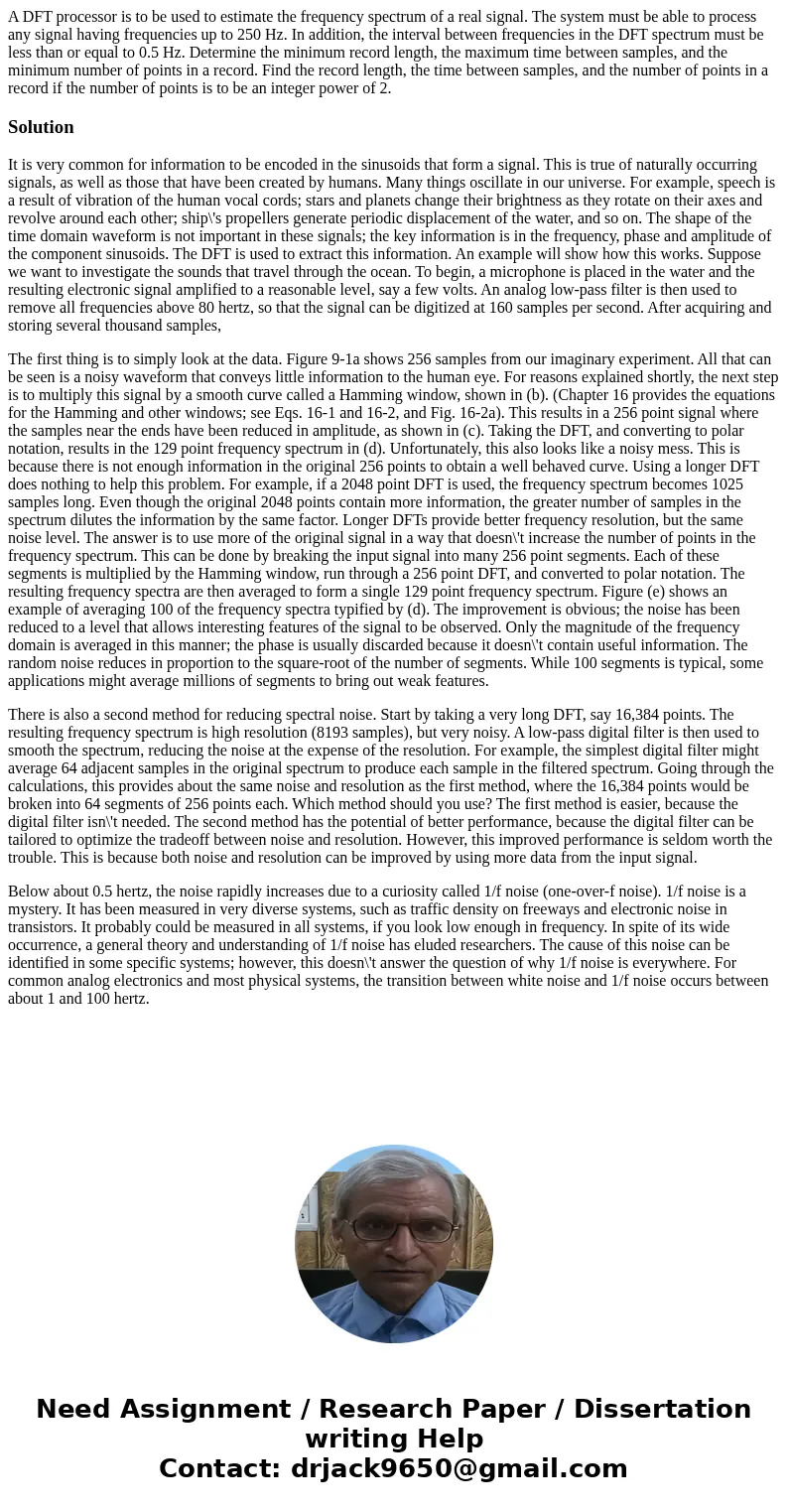A DFT processor is to be used to estimate the frequency spec
Solution
It is very common for information to be encoded in the sinusoids that form a signal. This is true of naturally occurring signals, as well as those that have been created by humans. Many things oscillate in our universe. For example, speech is a result of vibration of the human vocal cords; stars and planets change their brightness as they rotate on their axes and revolve around each other; ship\'s propellers generate periodic displacement of the water, and so on. The shape of the time domain waveform is not important in these signals; the key information is in the frequency, phase and amplitude of the component sinusoids. The DFT is used to extract this information. An example will show how this works. Suppose we want to investigate the sounds that travel through the ocean. To begin, a microphone is placed in the water and the resulting electronic signal amplified to a reasonable level, say a few volts. An analog low-pass filter is then used to remove all frequencies above 80 hertz, so that the signal can be digitized at 160 samples per second. After acquiring and storing several thousand samples,
The first thing is to simply look at the data. Figure 9-1a shows 256 samples from our imaginary experiment. All that can be seen is a noisy waveform that conveys little information to the human eye. For reasons explained shortly, the next step is to multiply this signal by a smooth curve called a Hamming window, shown in (b). (Chapter 16 provides the equations for the Hamming and other windows; see Eqs. 16-1 and 16-2, and Fig. 16-2a). This results in a 256 point signal where the samples near the ends have been reduced in amplitude, as shown in (c). Taking the DFT, and converting to polar notation, results in the 129 point frequency spectrum in (d). Unfortunately, this also looks like a noisy mess. This is because there is not enough information in the original 256 points to obtain a well behaved curve. Using a longer DFT does nothing to help this problem. For example, if a 2048 point DFT is used, the frequency spectrum becomes 1025 samples long. Even though the original 2048 points contain more information, the greater number of samples in the spectrum dilutes the information by the same factor. Longer DFTs provide better frequency resolution, but the same noise level. The answer is to use more of the original signal in a way that doesn\'t increase the number of points in the frequency spectrum. This can be done by breaking the input signal into many 256 point segments. Each of these segments is multiplied by the Hamming window, run through a 256 point DFT, and converted to polar notation. The resulting frequency spectra are then averaged to form a single 129 point frequency spectrum. Figure (e) shows an example of averaging 100 of the frequency spectra typified by (d). The improvement is obvious; the noise has been reduced to a level that allows interesting features of the signal to be observed. Only the magnitude of the frequency domain is averaged in this manner; the phase is usually discarded because it doesn\'t contain useful information. The random noise reduces in proportion to the square-root of the number of segments. While 100 segments is typical, some applications might average millions of segments to bring out weak features.
There is also a second method for reducing spectral noise. Start by taking a very long DFT, say 16,384 points. The resulting frequency spectrum is high resolution (8193 samples), but very noisy. A low-pass digital filter is then used to smooth the spectrum, reducing the noise at the expense of the resolution. For example, the simplest digital filter might average 64 adjacent samples in the original spectrum to produce each sample in the filtered spectrum. Going through the calculations, this provides about the same noise and resolution as the first method, where the 16,384 points would be broken into 64 segments of 256 points each. Which method should you use? The first method is easier, because the digital filter isn\'t needed. The second method has the potential of better performance, because the digital filter can be tailored to optimize the tradeoff between noise and resolution. However, this improved performance is seldom worth the trouble. This is because both noise and resolution can be improved by using more data from the input signal.
Below about 0.5 hertz, the noise rapidly increases due to a curiosity called 1/f noise (one-over-f noise). 1/f noise is a mystery. It has been measured in very diverse systems, such as traffic density on freeways and electronic noise in transistors. It probably could be measured in all systems, if you look low enough in frequency. In spite of its wide occurrence, a general theory and understanding of 1/f noise has eluded researchers. The cause of this noise can be identified in some specific systems; however, this doesn\'t answer the question of why 1/f noise is everywhere. For common analog electronics and most physical systems, the transition between white noise and 1/f noise occurs between about 1 and 100 hertz.

 Homework Sourse
Homework Sourse